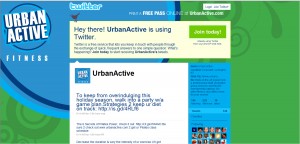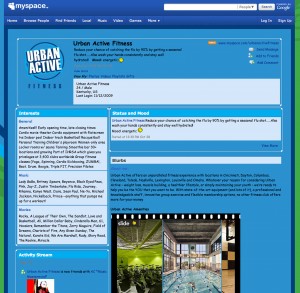 In this new world of media and marketing there are a lot of options for club owners. A lot of clubs, such as Urban Active and Anytime Fitness, have utilized social networking to get their message to the public – for many clubs, the age-old direct mailing of local residents attracts members. However, one thing is for certain, if you can’t get your marketing strategies to work, you aren’t going to be a successful club.
In this new world of media and marketing there are a lot of options for club owners. A lot of clubs, such as Urban Active and Anytime Fitness, have utilized social networking to get their message to the public – for many clubs, the age-old direct mailing of local residents attracts members. However, one thing is for certain, if you can’t get your marketing strategies to work, you aren’t going to be a successful club.
“Technology is everywhere,” said Libby Crocker, brand strategist with Anytime Fitness. “We try to interject some human interest into our ‘techie methods’ of outreach.” Crocker explained how member success stories have been broken down into short video e-mails and sent to prospects. These basic inspirational e-mail blasts really affect a person who has wanted to make drastic changes in their lifestyle.
For KT Remus, the senior marketing director for Urban Active, many of the same strategies they’ve been using for years still drive business. “We are still using the same message, ‘we are the fitness solution,’” she explained. “We make sure to promote the amenities that members enjoy. The key is to make the marketing piece appealing to as many segments of the population as possible so that one marketing piece can appeal to more types of members.”
With the economy still struggling, one of the biggest marketing solutions has been stretching marketing dollars. One category can’t afford to be left out while clubs wait for the economy to recover. New, cheaper ideas, such as basic grassroots marketing, have to be implemented to reach each specific age, financial and social category.
“It’s important that we establish an emotional connection with consumers to get them into the gym and that when we do…we keep that connection throughout the lifecycle of their membership,” said Cody Pierce, the director of franchise marketing for Gold’s Gym International. Gold’s Gym International refers to their members as ‘the committed.’ They’ve used this type of mind frame to set up successful marketing campaigns that reach out to the unfit population. “We’ve decided to market to the millions of other people out there who see themselves as committed – whether that’s a commitment they have to their families, their jobs or their health,” he added. “We’ve launched a campaign to target people with this mindset, or those that aspire to have it.”
Regardless of where your club may be demographically or economically, one common marketing outlet has showed success, and at a relatively cheap price. “It is clear to everyone in the industry that the Internet is an integral way of doing business,” said Brett Beshey, the president of Buddy Referral Systems. “The use of Internet based products allows the club to reach out in ways it never could have before, at a fraction of the cost.”
Back to the Future
Times are changing and you have to be ready to change with them. One major movement in fitness has been to bring people back to the idea of community. Everyone wants to reach out to the residents that live in a five-mile radius. You have to utilize the Internet and focus your energy on your local bread and butter.
“Anytime Fitness has launched a 2010 marketing plan consisting of five different campaigns,” Crocker said. “Our franchisees have the freedom to select the campaign and modify offers and other pertinent information to make it specific to their local market.” Matt York with Premier Fitness Marketing, a marketing firm devoted to health and fitness clubs, said “Consumers have been overwhelmed with the same old price-point marketing. As we found this stale marketing, such as ‘join now and save, no enrollment fees or buy one get one free’ messages, were becoming less effective, we have come up with new and different marketing strategies to spark their interest. Consumers are also much wiser and do not fall for the old bait and switch type of used marketing.” York suggested that clubs find their target market and pursue it regularly with different forms of media.
“One of the biggest challenges clubs have is how to differentiate themselves from everyone else out there trying to cut into the club-membership pie,” said Craig Pepin-Donat, the chief marketing officer for dotFit Worldwide. “In the past, it was about what was offered in the box, which is what most clubs focus on in their marketing efforts. At dotFIT, our years of experience operating clubs has proven that there is a revolutionary shift taking place with health minded consumers, and clubs that fail to recognize this shift will struggle to stay profitable long term. I see the shift to continue with more online communication, enhanced tools that give members the flexibility to monitor their results to their goals and give them a way to communicate with others who share similar interests through social networking. Clubs can get out in front of this trend by connecting with companies to provide those features and who have already invested the money in developing that type of technology.”

“Don’t walk into social media networking naïve. It can be scary,” Remus explained. “At first it’s a shiny new penny. It’s free and very effective at getting your message out…what marketing person wouldn’t like that? Be fully aware that at any given time that a disgruntled member, employee or your competition has free reign to post whatever message they desire on your page. If you have one sales person that has a bad day and upsets a member, then that message can be blasted out to the world.” Although, as scary as it may seem, Remus said it’s a necessary risk. “The good part is, I can broadcast a message to my members in less than 30 seconds for free versus setting up an e-mail blast,” she continued. “Social media networking is a daily task. Definitely a wonderful marketing tool but be prepared to spend time on it and listen to what your customers are saying. ”
To keep members and prospects involved with Facebook and Twitter pages, Urban Active uses health and fitness posts from other sites. Although, these posts may not take the reader to the Urban Active Web site, it still constantly bombards viewers with the Urban Active name prior to them clicking on the link.
A New Digital Spin
The Internet has opened up a ton of new venues for marketing strategies. Almost every fitness club has a customized Web site, and almost every member has Internet access. However, after years and years of Web access, how marketable is your Web site?
The goal with new digital marketing is getting members and prospects associated with your Web site, again. A Web site can be a major marketing tool. It can have all of your club specials and programs listed in easy-to-view designs. You can incorporate video and music to get prospects excited about your club. However, keep in mind that your prospects are probably already overloaded with news, comedy, sports and any other topics floating through cyberspace. You have to look for other ways to grab their attention.
“We have developed a free educational Webinar series that our license partners can promote to their members,” Pepin-Donat said. “This is so important because we know the average club will only penetrate 10 to 15 percent of their member base with personal training and less with fitness orientations. We also have a fully integrated administrative console where club operators have complete visibility into the exact results the program is having in terms of revenue generated by trainer, member, club, district, region or division.” dotFit uses highly experienced people from the fitness industry to help bring accurate information about an owner’s club to the owner’s fingertips.
Urban Active has started using Web access to their advantage away from their Web site. Facebook and Twitter is one step, but it’s not the final solution. “I’m doing a lot of variable and automated marketing,” Remus explained. “We’ve seen an amazing response. It’s software driven and it’s automated. Right now we are doing renewals and next month we are doing new members. We can do e-faxes, voice blasts, e-mails – you design it one time and it applies to the new member or renewal on a sequence basis.”
“When a club caters to a community and creates a destination through social marketing, it changes the game,” Beshey said. “It levels the playing field and makes it something that everyone can support and be involved in. The form of getting these potential members involved is by direct contact and encouragement from a member in that community, that is what our system automates for club owners.”
Buddy Referral System develops a predetermined e-mail that can easily be sent out to a member’s entire address book. “We have not reinvented the wheel of word-of-mouth advertising, just perfected a way for it to spread faster than possible in the past,” Beshey said about his company. “At the end of the day it’s simple math when it comes to adding growth. The more people spreading the word about your club, the more you can convert to new members!”
Upcoming Marketing
The sad part about marketing is its always changing. But, the good side is there is always a solution, you just have to think outside the box. “In the next three to five years we foresee more and more clubs moving to have a very strong Internet and social presence,” Beshey said. “We feel that advertising dollars and budgets will be allocated differently then they have in the past and these areas will be a main focus.”

Clubs have to focus on local community. If a club only has one or two branches, it doesn’t make sense to advertise with the local NFL team – regardless of how much money the club makes. “People workout based on convenience,” Remus added. “They may join because it’s bigger, better, but they will not go if it’s too far away. If you poll your membership base, you will see that most of your members live in that five-mile radius.”
Couch potatoes have to be targeted into 2010, 2011 and throughout the future. This massive 85 percent of the population is in the minds of just about every club on the planet. However, the spuds don’t seem to be budging. Your club has to implement solid marketing strategies that attack this section of the population. As a club, the knowledge about fitness and the health benefits are there. “With obesity skyrocketing in the country and billions of dollars being spent to treat preventable illness, we know that the product we have to offer is an important part of improving the health of America,” Pierce said. “The days of simply putting and ad in the paper or doing a direct mail campaign are over. We’re combining traditional advertising with new online marketing technologies.”
Marketing is the solution, but it will take work to get a club into the new age. The old school ideas of even five years ago no longer apply. People are changing the way they think minute to minute – clubs have to change with these people. It’s not going to be easy, but it can be done. Get your strategies together, prepare your budgets and bring in the members and improve retention with the right marketing campaigns in 2010. -CS
By Tyler Montgomery










